Friday essay: lessons from stone – Indigenous thinking and the Law
- Written by Tyson Yunkaporta, Senior Lecturer Indigenous Knowledges, Deakin University
In Dreaming stories, Emu is often a narcissist who damages social relationships. These stories teach us about the protocols for living sustainably, and warn us about unsustainable behaviours. The basic protocols of Aboriginal society, like most societies, include respecting and hearing all points of view in a yarn.
Narcissists demand this right, then refuse to allow other points of view on the grounds that any other opinion somehow infringes their freedom of speech or is offensive.
They destroy the basic social contracts of reciprocity (which allow people to build a reputation of generosity based on sharing to ensure ongoing connectedness and support), shattering these frameworks of harmony with a few words of nasty gossip. They apply double standards and break down systems of give and take until every member of a social group becomes isolated, lost in a Darwinian struggle for power and dwindling resources that destroys everything. Then they move on to another place, another group. Feel free to extrapolate this pattern globally and historically.
We have stories for this behaviour, memorial stones scattered along songlines throughout the landscape, victims and transgressors transformed into rock following epic struggles to stand for all time as cautionary tales. Clancy McKellar, a Wangkumarra Songman, took me to a site where three brothers who had kidnapped women were punished and turned to stone.
All over that place in Tibooburra the red rocks are people turned to stone for breaking the Law or messing around too much with weather modification rituals. There is Law and knowledge of Law in stones. All Law-breaking comes from that first evil thought, “I am greater-than,” that original sin of placing yourself above the land or above other people.
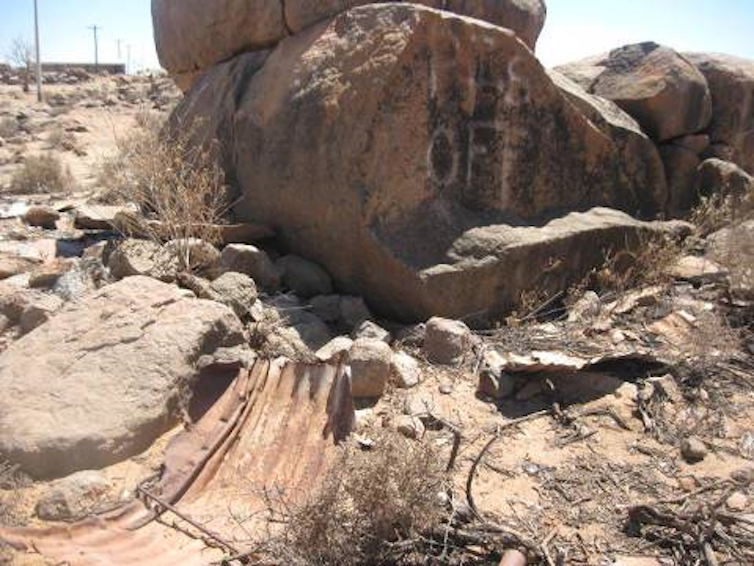 Red Rocks at Tibooburra.
Author provided
Red Rocks at Tibooburra.
Author provided
In our traditional systems of Law we remember, however, that everyone is an idiot from time to time. Punishment is harsh and swift, but afterwards there is no criminal record, no grudge against the transgressor. Perpetrators are only criminals until they are punished, and then they may be respected again and begin afresh to make a positive contribution to the group.
In this way, people will not lie and shift blame or avoid punishment by twisting rules to escape accountability. They can look forward to a clean slate and therefore be willing and equal participants in their own punishment and transformation, which is a learning process more than anything else.
This is perhaps something of value to be taken from our stone stories to make justice systems more effective and sustainable today. Those old criminals in stone all over this country are not despised figures, but respected entities who received their punishment and are now revered in their roles of keeping the Law. If we respect them and hear their stories, they can tell us how to live together better.
Read more: Explainer: the seasonal 'calendars' of Indigenous Australia
Albino boy
But I don’t know very much about rocks. I feel more at home on open savannah and dry sclerophyll bushlands, and my Story Place has only one stone, which moves around of its own accord and so is in a different position every time you go there. It arrived from Asia, carried by a cyclone, and never quite settled down to live slowly like other rocks. So I need to yarn with somebody who really understands the way stone works. As usual, I seek the most insightful knowledge in the most marginalised point of view. I talk to a young Tasmanian Aboriginal boy called Max.
Max has silvery white hair and alabaster skin. He looks and talks like he’d be more at home riding a dragon than a stock horse. He’s a proper nerd, memorising hundreds of digits of pi for no particular reason, thinking his martial arts skills are much better than they really are, and carrying around an encyclopaedic knowledge of elves and hobbits and superheroes. He can also write songs in his ancestral language that make me cry.
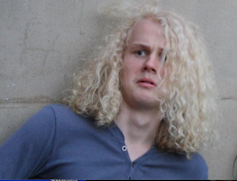 Max.
Author provided
Max.
Author provided
We’ve spent a lot of time sparring in a traditional style that was once done with stone knives. The rules of engagement are that you can only cut your opponent on the arms, shoulders or back (extremely difficult to do) and — here’s the kicker — at the end of the fight the winner must get cut up the same as the loser, so that nobody can walk away with a grudge.
It’s hard enough to cut somebody on the back with a stone knife when they’re trying to do the same to you, but it’s even harder when you know that every time you cut them you’re really just cutting yourself.
In our yarns following these sessions we decided this kind of combat forces you to see your enemy’s point of view, and by the end of it you can no longer be opponents because you’re connected by mutual respect and understanding. More lessons from stone — but how to apply these today? Sounds like a good opportunity for a thought experiment.
I guess if you wanted to take a contemporary economy that is dependent on perpetual war and try to make it sustainable, you could start by applying similar rules of engagement. But in the stone-knife model, enemies are a non-renewable resource and eventually you would run out of them. It would not be sustainable at all for the war machine if everybody ended up respecting all points of view.
Perhaps the transferable wisdom here is simply that most young men need something a little meatier than mindfulness workshops to curtail the terrifying narcissism that overtakes them from the moment their balls drop. Maybe then they won’t grow up to be the men who start wars in the first place.
This brings us back to that foundational flaw, that Luciferian lie: “I am greater than you; you are lesser than me.” Because his appearance does not match some people’s idea of his cultural identity, Max faces abusive encounters grounded in that foundational flaw daily. His identity is constantly questioned by both Aboriginal and non-Aboriginal people who place themselves in a greater-than position and get a little thrill out of pronouncing judgement on his existence. Max reflects on these encounters, deciding that these people lack their own authentic identities and therefore can only find comfort in assaulting his.
Max may not know everything about his lineage or his culture, both of which were catastrophically disrupted by large-scale genocide, but he knows who he is, and the fragments of cultural knowledge he carries have integrity and value. He applies the pattern in those fragments to every aspect of his life.
I don’t know what I’d be if I didn’t have my identity, because I haven’t really known a life without it. I can’t discern parts that are Indigenous and parts that are not because all of my actions are Indigenous — the way I move through the world, my social interactions, my way of thinking about anything. It bleeds through you no matter what.
When Max recites a hundred digits of pi he is not stepping outside of his identity; he is singing a pattern of creation from north to south. He does not need to have an Elder’s level of knowledge to do this. He needs only to perceive the pattern in what he does know.
Keepers of knowledge see him behaving in this way and know he is ready to be responsible for additional knowledge, so pass on story to him. This is how Indigenous Knowledge works.
Strong no matter what
Max teaches me about rocks, because Tasmanian people have a particular connection to rocks.
Stones to me are the objects that parallel all life, more so than trees or mortal things because stones are almost immortal. They know things learned over deep time. Stone represents earth, tools and spirit; it conveys meaning through its use and through its resilience to the elements. At the same time it ages, cracking and eroding as time wears it down, but it is still there, filled with energy and spirit.
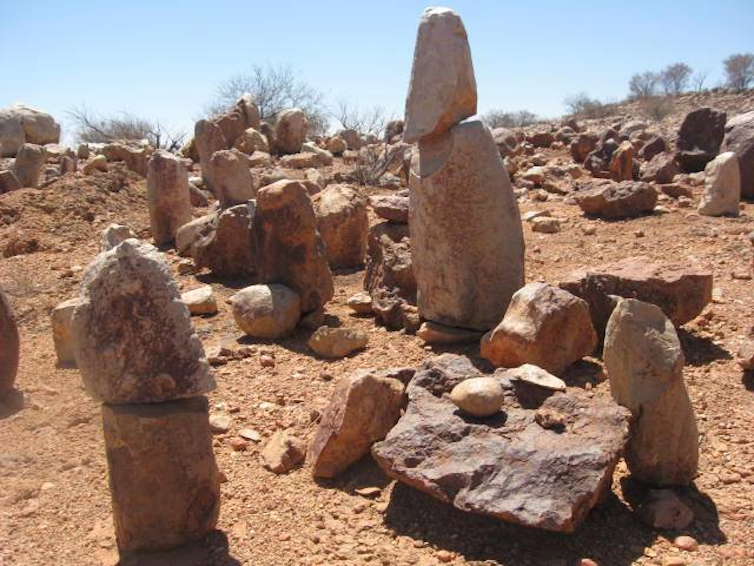 The Albino Boy sacred site: a massive complex of carved standing stones in north west New South Wales.
Author provided
The Albino Boy sacred site: a massive complex of carved standing stones in north west New South Wales.
Author provided
We yarn about the sentience of stones and the ancient Greek mistake of identifying “dead matter” as opposed to living matter, limiting for centuries to come the potential of western thought when attempting to define things like consciousness and self-organising systems such as galaxies. They viewed space as lifeless and empty between stars; our own stories represented those dark areas as living country, based on observed effects of attraction from those places on celestial bodies.
Read more: How ancient Aboriginal star maps have shaped Australia's highway network
Theories of dead matter and empty space meant that western science came late to discoveries of what they now call “dark matter”, finding that those areas of “dead and empty” space actually contain most of the matter in the universe.
This brings us back to Elder of the Nyoongar people, Uncle Noel Nannup’s, creation story of when Emu went nuts with narcissism and demanded to become the boss of creation. In that story, the pre-creation reality was that space was solid: it sat heavily upon the ground, crushing everything that attempted to come into being. Earth and sky had to be separated, the Ancestors lifting up the heavens physically.
Sky country is seen in our stories as tangible, having mass, in a way that reveals an understanding of dark matter. All that celestial territory is in constant communication with us, exerting forces upon us and even exchanging matter in the form of rocks crashing through our atmosphere. Our stories show our ancient understanding of the way asteroids form craters, a realisation that only entered scientific knowledge a few short decades ago.
Max and I yarn about how our knowledge of these things cannot have always been unique to our culture alone, as the ancient names for constellations are often the same as ours throughout the world — the seven sisters, the two brothers, the eagle, the hunter.
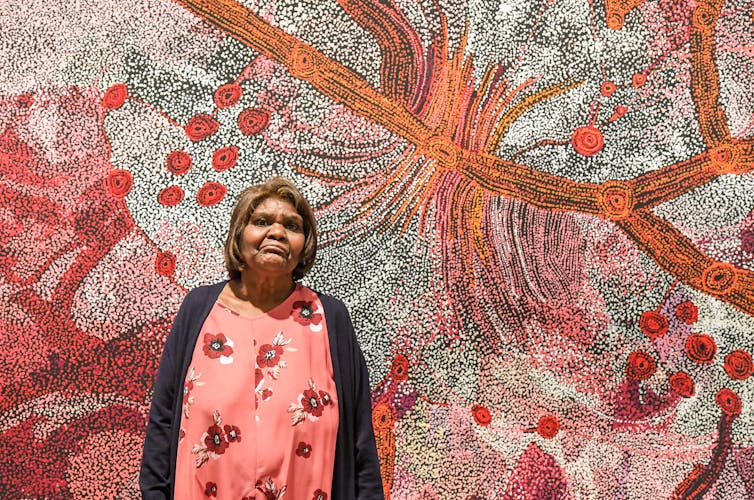 Sylvia Ken, winner of the 2019 Wynne Prize, with her painting of the Seven Sisters at the Art Gallery of NSW in May.
Peter Rae/AAP
Sylvia Ken, winner of the 2019 Wynne Prize, with her painting of the Seven Sisters at the Art Gallery of NSW in May.
Peter Rae/AAP
These are global stories and systems of knowledge that must have once been common to all people. We think something terrible must have happened in the north to make people forget, causing science to have to start all over again from scratch rather than building on what went before. What could this cataclysm have been?
I imagine the Black Death couldn’t have helped, but I suspect it began earlier than that. I think the Emu deception got out of hand somewhere and spread, causing more and more people to think themselves greater than the land, greater than others, greater than the women who hold our lives in their hands and bellies. Whatever it is, this cataclysm is growing and I wonder how we can stand against it.
Max responds:
Stone teaches us that we should be strong no matter what tries to crack us or wear us down, keeping an unbreakable core through your culture and your beliefs. The majority of this earth is rock, and while water and plants make up its surface, the body of the earth, the part that keeps it all together, is rock.
You can have life and creation but it will all crumble without a solid base, same with society, companies, relationships, identities, knowledge, almost anything both tangible and intangible. Like those forests and trees sitting as a skin over the rocks of the earth — without that strength inside, without that stone, it would crumble.
Uluru rocks
Thinking about the shape of the world Max describes and the thin skin around it, I reflect on the physics of our creation stories and the way rocks wear away over time into balls.
I perceive a pattern in the universe whereby the most efficient shape for holding matter together is a sphere. I might say to the growing numbers of flat-earth theorists out there, “Blow me a flat bubble and I’ll consider your theory.” But that would be placing myself in a greater-than position, so I need to check myself and pay attention to them, remembering that there is always value in marginal viewpoints.
So I listen to them online and realise that the sphere is not the final shape of this creation process. Our own galaxy began as a sphere and flattened into a disc and the earth is gradually flattening itself too, as it spins like a lump of clay on a wheel. It’s only flattened by just over 20 kilometres at the poles so far, but it’s getting there. It’s a good thing I didn’t dismiss the flat-earthers out of hand, otherwise I might never have understood that properly.
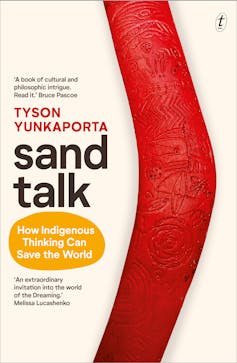 But what use could come from that kind of thinking? Well, thought experiment might yield a few applications. Packaging, for example, might make more efficient use of space and resources if we considered that you can get a hell of a lot more into a small sphere than a big box.
But then what would stop those spheres rolling off the shelves? The flat-earthers resolve this — just squash the spheres down a bit. Thank you, flat-earthers. That innovation could save a bit of landfill, buy us a little time.
Max thinks it will take a bigger shift in thinking to stave off planetary destruction, that we need to learn more about respect from the stones. I agree — the understanding that we are no greater or lesser than a rock would certainly change things if a critical mass of people all came to it at once.
Anyone who thinks they’re better than a rock should be turned into one — then they would find out they’re not that special, and they could finally be happy. Max suggests that in recent decades people have been becoming aware of rock spirit, reminding me of what has been going on at Uluru.
There is a shed there full of rocks. For a long time, tourists took stones away from that sacred site as souvenirs, then a few decades ago something strange began to happen. The tourists started mailing the rocks back with panicked reports of weird happenings, disturbed sleep, bad luck, ghostly visitations and terrible accidents. Somehow they knew it was because of the rocks, and were sending them back with desperate apologies. So many were returned that they had to build a big storage shed to house them.
In our Law we know that rocks are sentient and contain spirit. You can’t just pick one up and carry it home, as you will disturb its spirit and it will disturb you in turn. If you sit at any campfire for a yarn with Aboriginal people anywhere on this continent, you will be sure to hear a cautionary tale about a relative who was silly enough to pick up a rock and take it home, who then got sick or was haunted or killed or went crazy.
A lot of rocks are benevolent and enjoy being used and traded, but you have to follow the guidance of the old people to know which ones you can use. Rocks are to be respected.
Perhaps further work needs to be done on what constitutes consciousness and what constitutes life. If the definitions of these things could include rocks as sentient beings, it would go a long way towards stemming the emu-like behaviours that are running rampant across the earth and cyberspace right now. Either that, or we could start mailing those Uluru rocks out to all the narcissists to give them a lesson in respect for others.
This is an edited extract from Tyson Yunkaporta’s Sand Talk: How Indigenous Thinking Can Save the World, Text Publishing.
But what use could come from that kind of thinking? Well, thought experiment might yield a few applications. Packaging, for example, might make more efficient use of space and resources if we considered that you can get a hell of a lot more into a small sphere than a big box.
But then what would stop those spheres rolling off the shelves? The flat-earthers resolve this — just squash the spheres down a bit. Thank you, flat-earthers. That innovation could save a bit of landfill, buy us a little time.
Max thinks it will take a bigger shift in thinking to stave off planetary destruction, that we need to learn more about respect from the stones. I agree — the understanding that we are no greater or lesser than a rock would certainly change things if a critical mass of people all came to it at once.
Anyone who thinks they’re better than a rock should be turned into one — then they would find out they’re not that special, and they could finally be happy. Max suggests that in recent decades people have been becoming aware of rock spirit, reminding me of what has been going on at Uluru.
There is a shed there full of rocks. For a long time, tourists took stones away from that sacred site as souvenirs, then a few decades ago something strange began to happen. The tourists started mailing the rocks back with panicked reports of weird happenings, disturbed sleep, bad luck, ghostly visitations and terrible accidents. Somehow they knew it was because of the rocks, and were sending them back with desperate apologies. So many were returned that they had to build a big storage shed to house them.
In our Law we know that rocks are sentient and contain spirit. You can’t just pick one up and carry it home, as you will disturb its spirit and it will disturb you in turn. If you sit at any campfire for a yarn with Aboriginal people anywhere on this continent, you will be sure to hear a cautionary tale about a relative who was silly enough to pick up a rock and take it home, who then got sick or was haunted or killed or went crazy.
A lot of rocks are benevolent and enjoy being used and traded, but you have to follow the guidance of the old people to know which ones you can use. Rocks are to be respected.
Perhaps further work needs to be done on what constitutes consciousness and what constitutes life. If the definitions of these things could include rocks as sentient beings, it would go a long way towards stemming the emu-like behaviours that are running rampant across the earth and cyberspace right now. Either that, or we could start mailing those Uluru rocks out to all the narcissists to give them a lesson in respect for others.
This is an edited extract from Tyson Yunkaporta’s Sand Talk: How Indigenous Thinking Can Save the World, Text Publishing.
Authors: Tyson Yunkaporta, Senior Lecturer Indigenous Knowledges, Deakin University
Read more http://theconversation.com/friday-essay-lessons-from-stone-indigenous-thinking-and-the-law-122617



